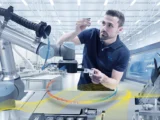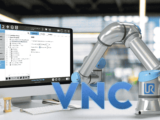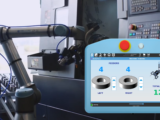Custom HMI for Collaborative Robots Teach Pendant
In the realm of manufacturing, HMIs (Human-Machine Interfaces) are indispensable tools that facilitate the seamless interaction between operators and complex systems, such as machines or production lines. These graphical interface panels offer a simplified and intuitive means for operators to control and monitor various functions, effectively concealing the underlying complexities.
When using collaborative robots, HMIs become even more important, because interaction between robots and operators is very frequent. Interaction is at the key for collaboration, so building a customized HMI is a must have solution to provide final users a supervising tool that they can use to interact with the robot in a smart way.
However, despite the availability of built-in teach pendant monitors in many collaborative robots, such as Universal Robots, it is common practice to install external HMI devices. This raises the question: why not leverage the existing teach pendant for HMI purposes?

Using external HMI devices instead of taking advantage of the already available robot teach pendant is clearly a bed practice, for several reasons:
- ❌ Inconsistency in User Experience: Adding another display alongside the robot default one force users to manage some data on the external HMI device and some other on the robot teach pendant. Breaking the one UI principle, which aims to ensure a consistent user experience within a single device and also a unified user experience, makes hard for users to understand where to perform operations.
- ❌ Increased Material Costs: Installing an external HMI has also the effect of increasing the overall cost of the application. Adding a further touch display, PLC for communication and control desk, can raise costs up to 3000 euros.
- ❌ Development Complexity: Integrating an external HMI with the robot controller requires additional development efforts, involving protocols and fieldbus. This complexity not only adds to the cost but also extends the development timeline, potentially delaying the deployment of the collaborative application.
To address these challenges, we have developed Robpod Studio, an integrated development environment for Universal Robots. Robpod Studio enables the design of custom HMI panels directly for the robot teach pendant, eliminating the need for external devices and displays.

Key features of Robpod Studio include:
- ✔️ Simplified Development: HMI panels can be created using a graphical drag-and-drop interface.
- ✔️ Seamless Integration: No fieldbus or protocol knowledge is required to integrate the robot program with the HMI panel. Robot variables and functions can be accessed directly from the HMI setup panel.
- ✔️ Improved User Experience: no need for external devices or displays. The HMI panels you design will be directly accessible on the robot’s teach pendant, integrated into the polyscope environment. This means users can easily monitor and control the application workflow within a single device, enhancing clarity and efficiency.
- ✔️ Reduced Costs: Following a pure software approach, it is not necessary to install further external devices, making it possible to create applications with a much more competitive return on investment for customers.
Robpod Studio comes with a very convenient developer based licensing policy: with a one-time purchase, you gain the freedom to program any robot without limitations. Even when the license expires, worry not – all your developed programs will continue to run smoothly without the necessity of renewal.
By choosing Robpod Studio, integrators can save up to 5000 euros for each application developed, while providing operators with a unified, intuitive, and cost-effective HMI solution for collaborative robotics.
You can download Robpod Studio and start designing custom HMI panels for Universal Robots teach pendant here:
Get Started Now!
👨💻 Read the Docs




